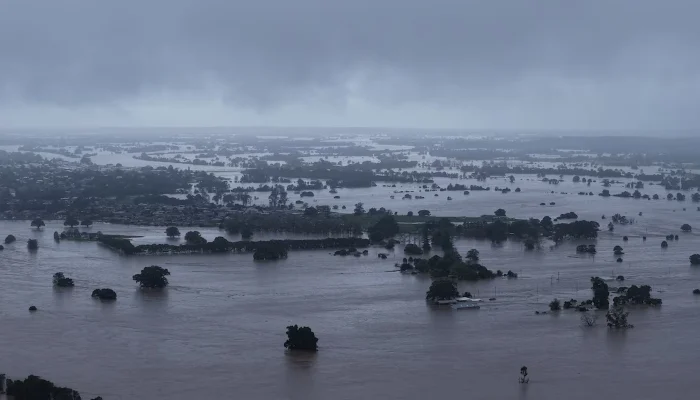The lifeless body of a man was discovered in a vehicle submerged in floodwaters in Australia’s southeast on Friday, elevating the confirmed death toll to four. This grim finding follows three consecutive days of relentless rainfall that have left entire towns cut off, decimated livestock, and destroyed numerous residences. Police reported that the man was located near Coffs Harbour, approximately 550 kilometers (342 miles) north of Sydney. The search operation continues for an individual who has been missing since the torrential downpour commenced earlier this week.
Emergency services personnel have indicated that around 50,000 people remain isolated. Residents returning to their waterlogged homes have been cautioned about various hazards. “Floodwaters have contaminants, there can be vermin, snakes… so you need to assess those risks. Electricity can also pose a danger as well,” stated state Emergency Services Deputy Commissioner Damien Johnston during a media briefing.
Television footage displayed inundated intersections and street signs, with cars submerged up to their windshields, after rapidly rising waters caused rivers to breach their banks in the Hunter and Mid North Coast regions of New South Wales, Australia’s most populous state. Debris from the floods, alongside deceased and displaced livestock, has been washed ashore on the coast.
Prime Minister Anthony Albanese announced that he was forced to cancel his scheduled visit to Taree, one of the most severely impacted towns, due to impassable floodwaters. “We did try… but that was not possible due to the circumstance, which I’m sure people understand,” Albanese told reporters from the town of Maitland in the Hunter region. “But our thoughts are with communities that are cut off at this point in time. And we’re here to basically say, very clearly, and explicitly you’re not alone.”
Australia has been experiencing an increasing frequency of extreme weather events, which some experts attribute to climate change. Following prolonged droughts and devastating bushfires at the close of the last decade, recurrent floods have wreaked havoc across the country since early 2021. “What once were rare downpours are now becoming the new normal – climate change is rewriting Australia’s weather patterns, one flood at a time,” commented Davide Faranda, a weather researcher at ClimaMeter, in a statement.
Disruptions in Sydney
A powerful weather system that deposited approximately four months’ worth of rain over three days shifted southward towards Sydney on Thursday, bringing heavy overnight rainfall. However, the weather bureau, in its latest update, anticipates an easing of conditions by Friday evening. A drone view from May 21, 2025, captured a flooded area in Tinonee, New South Wales, Australia, after the heavy rains. — Reuters
Water accumulation on rail tracks impacted several suburban train lines in Sydney, including services to the airport. Sydney Airport itself was compelled to temporarily close two of its three runways for one hour on Friday morning due to strong winds, resulting in delayed flights. Officials have warned that Warragamba Dam, which supplies 80% of Sydney’s water and is currently at approximately 96% capacity, could potentially spill over.



